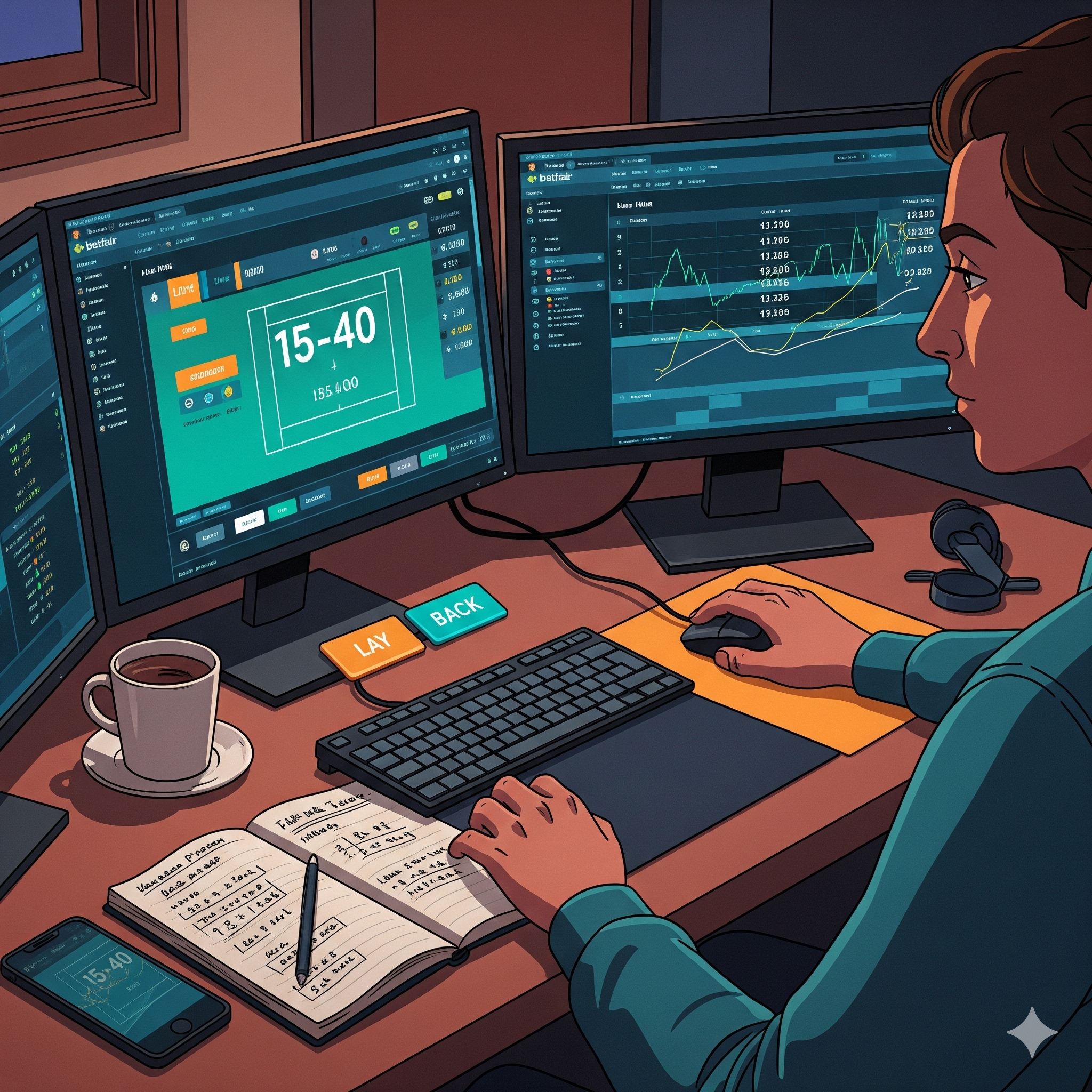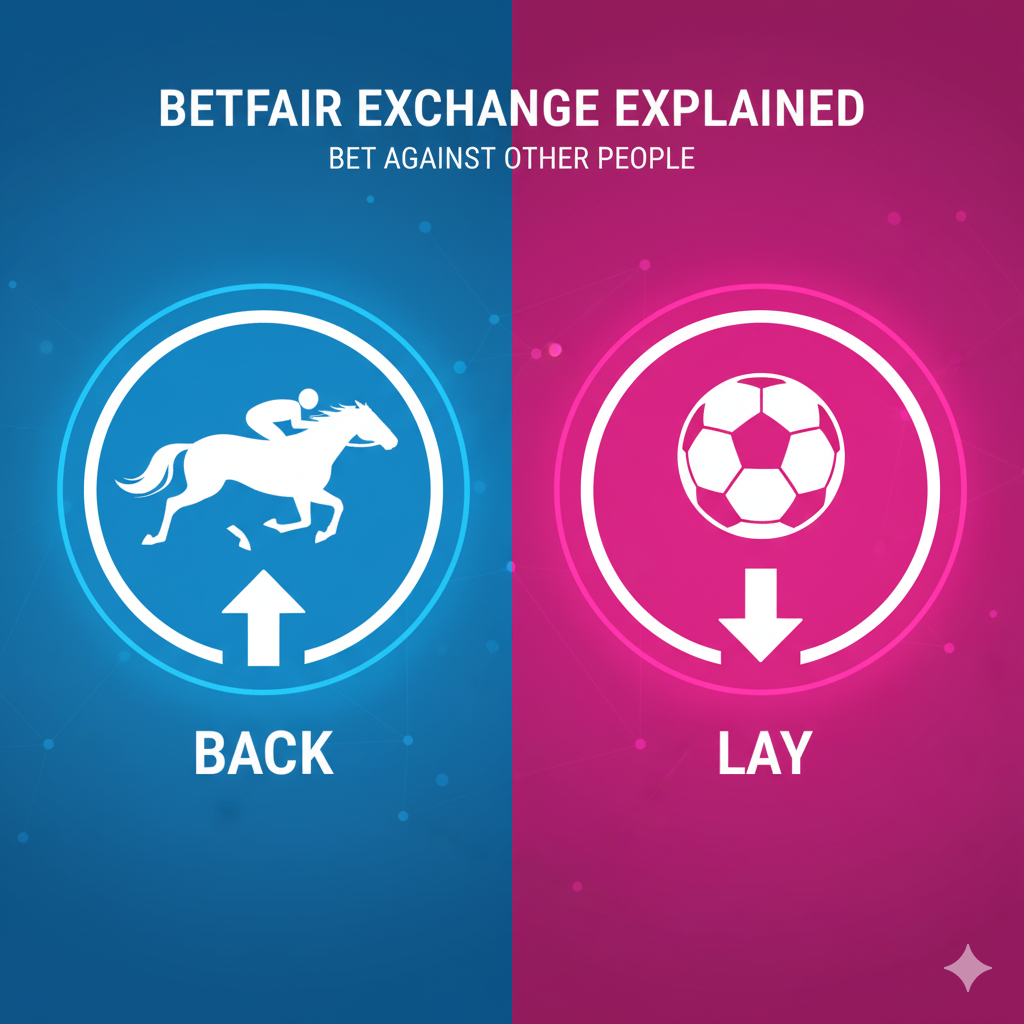Navigating the fast-paced world of in-play sports betting can be daunting, but for those who master the art of trading, it can be a highly profitable endeavor. Unlike traditional gambling where you place a single bet and wait for the outcome, sports trading involves actively buying and selling positions on a betting exchange to lock in a profit, regardless of the final result.
While a number of sports lend themselves to trading, tennis is arguably one of the most popular and volatile. The constant shifts in momentum, the clear scoring structure, and the presence of just two players create a perfect environment for price swings that traders can capitalize on.
One of the oldest and most well-known tennis trading strategies is the “15-40.” It’s a method that focuses on a very specific, high-leverage moment in a tennis match. This blog post will serve as a comprehensive guide to the 15-40 strategy, breaking down its mechanics, assessing its pros and cons, and providing expert tips to help you apply it effectively.

What is the 15-40 Tennis Trading Strategy?
The 15-40 strategy is a live, in-play method that revolves around a critical moment in a single tennis game. The name itself reveals the entry point: you wait for the score to reach 15-40, with the server being the player on 15. The player on 40 has two “break point” opportunities, meaning if they win either of the next two points, they will break the opponent’s serve and win the game.
The core premise of this strategy is that when a player faces a 15-40 deficit on their serve, the odds for them to win the game and the match will lengthen significantly. The market, in anticipation of a break of serve, moves to reflect the increased probability of the receiver winning the game. This is where you, the trader, step in.
The Mechanics: How It Works in Practice
Here’s a step-by-step breakdown of how you would execute the 15-40 trading strategy on a betting exchange like Betfair or Smarkets:
- Select Your Match: Not all matches are suitable for this strategy. You need a match with high liquidity, which means there is a large amount of money available to be matched. This ensures that you can enter and exit your position quickly without getting stuck. Matches involving top-ranked players, especially in Grand Slams or major tournaments, are often the best choices.
- Go In-Play: You must be watching the match live. Relying on a live score service is not enough, as there can be a delay of several seconds, which is a lifetime in fast-moving markets. Watching a live stream on your betting exchange or a television broadcast is essential.
- Wait for the Score: You patiently watch the game unfold until one player is serving and the score reaches 15-40 in favor of the receiver. This is your cue to act.
- Place Your Bet: At this point, you “back” the player who is currently leading the game at 40. This is a bet on them to win the game, which will result in a break of serve. You are betting that the server will succumb to the pressure and lose the game. The odds for this player will have just shortened, but there is still often enough room for a profitable move.
- Monitor the Next Point: The success of your trade hinges on what happens on the next point.
- Best-Case Scenario: The player you have backed wins the point, winning the game and breaking serve. The odds for this player to win the match will then shorten dramatically. This is your moment to “lay” the same player at the new, lower price. By doing so, you have locked in a profit regardless of the match’s final outcome. This process is often called “greening up” or “hedging.”
- Worst-Case Scenario: The server wins the next point, bringing the score to 30-40. The odds will then move back in favor of the server, and your initial back bet will be at a loss. Your goal here is to get out of the trade as quickly as possible by “laying” your selection at a higher price to cut your losses.
- Another Scenario: The server wins the next two points, bringing the score to Deuce (40-40). The odds will again shift, and you will need to lay your position to exit the trade, likely for a small loss.
Why the 15-40 Strategy Used to Be So Powerful
In the early days of sports trading, this strategy was a goldmine for many. The markets were less mature, and the price movements were more predictable and pronounced. When a player faced a 15-40 deficit, the odds would often overreact, creating a clear opportunity for a trader to get in, capture a few ticks of profit on the next point, and get out.
The logic was sound: a player with two break point opportunities has a high statistical probability of winning the game. The market’s reaction to this, especially when it was less sophisticated, was a reliable source of short-term profit.
The Evolution of the Strategy: Why it’s Not a “Set-and-Forget” Method Anymore
As the sports betting markets have matured and become more efficient, the 15-40 strategy has lost some of its edge. Today, the markets are smarter and anticipate these high-leverage situations.
- Anticipation and Minimal Price Movement: For top-tier men’s tennis, where serve is a dominant weapon, the market often anticipates a comeback from the server. The odds might not move as much at 15-40 as they would in a women’s match. Conversely, in women’s tennis, where breaks are more common, a 15-40 score might not cause a significant price swing because it’s an expected part of the match’s rhythm.
- The Statistical Reality: A key insight that has been highlighted by experienced traders is that a male server at 15-40 is still, statistically, the favorite to hold their serve. This is due to the power and accuracy of the male serve. The strategy, therefore, goes against the raw statistics, making it a higher-risk play than it once was.
- The Importance of Context: A successful trader today must do more than just wait for the score to appear. They must take into account the context of the match:
- Player Form: Is the server a big-serving specialist or a weaker server? Is the receiver a great returner?
- Match Situation: Is it the first game of the match, or a critical moment in a deciding set? The pressure on a player at 15-40 in the final set is far greater than in the first set, and the price movement will reflect this.
- Court Surface: Is the match on a fast surface like grass, which favors the server, or a slow surface like clay, which favors the returner?
Tips for a Modern Approach to the 15-40 Strategy
While the original “back and lay” method at 15-40 may be less profitable than it once was, the core principles can be adapted for a more sophisticated, modern approach.
- Focus on Specific Player Matchups: Instead of applying the strategy blindly, look for matches where it makes sense. Target a big server playing against a weak returner. When the server goes 15-40 down, there is a good chance the market is overreacting, and you can “back the server” to hold.
- Scalp, Don’t Trade: Given the reduced price movements, the 15-40 strategy is often better suited to “scalping” than “trading.” Scalping is the art of getting in and out of the market for tiny profits (often just a few “ticks,” or price movements) very quickly. You are looking for a small, predictable price bounce rather than a massive swing.
- Use a Trading Application: The Betfair website is not fast enough for this kind of short-term trading. You need a dedicated trading application like Bet Angel, Geeks Toy, or Fairbot. These tools provide a “ladder” interface that allows for one-click betting and lightning-fast execution.
- Embrace Dynamic Trading: The best traders don’t rely on a single, mechanical strategy. They use strategies like 15-40 as a foundation but adapt their approach based on what they see happening on the court. They might spot a player struggling with their movement or a visible drop in morale, and these insights can be far more valuable than a simple scoreline.
- Manage Your Risk: As with all trading, risk management is paramount. Only ever trade with money you can afford to lose. Start with small stakes to test the strategy and your execution. If a trade goes against you, don’t let it run. Exit for a small loss and move on to the next opportunity.
A Deeper Dive: Applying Critical Criteria
A crucial aspect of applying the 15-40 tennis trading strategy is understanding the nuances that separate profitable trades from losing ones. Blindly entering a trade based on a scoreline is a recipe for disaster. Successful traders consider critical criteria like gender, court surface, and key player statistics.
Men’s vs. Women’s Tennis: A Tale of Two Markets 🎾
When it comes to trading, men’s (ATP) and women’s (WTA) tennis are fundamentally different. It’s a mistake to apply the same strategy to both.
- Men’s Tennis (ATP): Men’s tennis is often characterized by dominant serving. Players hold serve a very high percentage of the time, so breaks are less common. This makes men’s tennis less volatile, and the odds don’t fluctuate as wildly. At 15-40, a strong male server can still be considered a favorite to hold serve, as they can rely on a powerful first serve to get out of trouble. The market, being more sophisticated, might already have factored in the server’s ability to save break points. This can make the 15-40 strategy less effective for a simple back-and-lay, as the price movement may be minimal. However, it can open up an opportunity to back the server at a higher price, betting on them to hold.
- Women’s Tennis (WTA): Women’s tennis is known for its greater volatility and more frequent breaks of serve. The serve is less of a weapon, leading to more extended rallies and more opportunities for the returner. As a result, the markets are more unpredictable, and price swings are more pronounced. When a WTA player goes 15-40 down, there’s a higher probability of a break. This can make the traditional 15-40 strategy of backing the receiver more viable, as the odds will often shorten dramatically after the break is converted. The key is to find players who are struggling on serve and a returner who is in good form.
In summary, men’s tennis is often better for long-term trades with less risk, while women’s tennis is better suited for short-term, high-volatility trades and scalping.
The Impact of Court Surface 🎾
The type of court surface has a huge impact on the effectiveness of the 15-40 strategy. Different surfaces favor different playing styles and directly affect the likelihood of a break of serve.
- Grass (e.g., Wimbledon): Grass is the fastest surface, which heavily favors the server. The ball skids low and fast, making it difficult for the returner to get a good read. The 15-40 strategy is most risky on grass because even an average server can hit a few aces or unreturnable serves to get out of trouble. The market knows this, and the odds for a server at 15-40 won’t change as drastically.
- Hard Court (e.g., Australian Open, US Open): Hard courts are the most neutral and widely used surface. They offer a more consistent bounce than grass or clay. This makes them a good middle-ground for the 15-40 strategy. It’s not as risky as grass, but you still have to be aware of big servers who can rely on their power to save break points.
- Clay (e.g., French Open): Clay is the slowest surface, which heavily favors the returner. The ball bounces high and slow, which neutralizes the power of a big serve. Rallies are longer, and players have more time to get into position. This is the best surface for the 15-40 strategy because breaks of serve are far more common. When a player goes 15-40 down on clay, there’s a strong likelihood they will be broken, and the odds will reflect this with a significant swing.
Match Stage and Momentum ⏱️
The timing of your trade within a match is crucial. The psychological pressure on a player can dramatically change the outcome of a game, and the market’s reaction to a 15-40 scoreline will reflect this.
- Early Sets (e.g., first few games): In the early stages of a match, players are still finding their rhythm. A 15-40 deficit is not a “make or break” moment. A server might hit a few aces to recover, and the odds will not swing as aggressively. Trading here is generally riskier, as the profit potential is lower.
- Decisive Games (e.g., late in a set or match): This is the most profitable stage for the 15-40 strategy. When the score is, for example, 4-4 in a set, or late in a deciding set, the pressure is immense. A break of serve is often the key to winning the set or the match. The market’s reaction to a 15-40 scoreline will be much more dramatic, as the odds will reflect the high stakes. This is where you can find the largest price swings and the best opportunities to “green up” for a significant profit.
How to Select and Execute the Trade
Here are the step-by-step criteria for selecting and executing a 15-40 trade effectively.
- Select the Gender, Market, and Liquidity:
- Gender: For a high-risk, high-reward back the receiver strategy, focus on WTA matches. The higher volatility and more frequent breaks of serve create more price swings, which are the lifeblood of this strategy.
- Surface: For this strategy, you should prioritize clay court matches. The slower surface neutralizes the serve and leads to more break opportunities, making the 15-40 scoreline a strong signal. Hard courts are a good alternative, while grass courts are generally not recommended due to the server’s advantage.
- Liquidity: Before you even consider a trade, check the volume of money matched in the market. For this fast-paced strategy, you need to ensure your bets are filled instantly and you can exit your position quickly. A good rule of thumb is to only trade on markets with a minimum of £50,000 to £100,000 matched for major events. For less significant tournaments, a minimum of a few thousand pounds matched can be a starting point for small stakes, but always be aware of the increased risk of getting stuck in an unmatched bet. The largest and most liquid exchange for tennis trading is Betfair (https://www.betfair.com).
- Select the Correct Match Stage:
- You can trade in any set, but for this strategy, you should focus on high-leverage situations to maximize potential profit and reduce risk.
- The best stage to enter this trade is in the decisive moments of a match, specifically in the late stages of a set (e.g., from 4-4 onwards) or in a final deciding set.
- Avoid the first few games of a match, as the pressure is lower and the price swings are less pronounced.
- Analyze the Match and Players:
- Pre-match: Look at the players’ historical stats on the specific surface. Focus on their break points saved percentage (for the server) and break points converted percentage (for the receiver).
- In-play: Watch the live match. Is the server struggling with their first serve? Is the receiver looking particularly sharp on returns? This qualitative analysis is just as important as the pre-match data.
- Use the Right Tools:
- Do not use the standard exchange website. You need a dedicated trading application that connects to the exchange’s API for faster data and execution.
- Recommended tools for Betfair include:
- Bet Angel: (https://www.betangel.com) – A professional-grade software with advanced features like live scores from the umpire’s chair and automated trading.
- Geeks Toy: (https://www.geekstoy.com) – A popular and powerful tool known for its speed and customization.
- Gather the Stats:
- You need reliable data to make informed decisions.
- Player Form and Stats: Check player form and statistics on official and reliable third-party sites.
- ATP Tour: (https://www.atptour.com/en/stats/leaderboard)
- WTA Tour: (https://www.wtatennis.com/stats)
- Tennis Explorer: (https://www.tennisexplorer.com/)
- Tennis Abstract: (https://www.tennisabstract.com/)
Conclusion: The Enduring Value of the 15-40 Concept
The 15-40 tennis trading strategy may not be the simple, high-profit method it was in its infancy. The markets are more efficient, and the edge has been eroded. However, the underlying concept—identifying a high-leverage moment where the market is likely to move in a predictable way—is timeless.
For the aspiring sports trader, understanding the 15-40 strategy is an essential lesson in market dynamics, price movement, and the importance of context. It teaches you to look beyond the surface of a game and find the hidden opportunities. While you may not use it as a standalone strategy, the principles you learn will form the foundation of more sophisticated and profitable trading in the future. In the ever-evolving world of sports trading, it is a reminder that the most successful traders are those who don’t just follow a system, but who truly understand the game.

Betfair Bot Reviews: Which One Suits You Best?
Which Automated Betfair bot Trading Software is Right For You? Choosing the best Betfair bot in 2025 can be a…

The Ultimate Betfair Trading Guide: History, Strategies
Betfair trading is the secret that professional gamblers don’t want you to know. For decades, the game was rigged. You…

Backtesting Guides
Backtesting Guide — Principles & MarketBook Replay | BotBlog Backtesting guides Published: 2025-11-11 • BotBlog Backtesting Guide — Principles &…

Lesson 7 — Risk management & deployment
Skip to content Lesson 7 — Risk management, hedging & deployment Final crypto lesson: implement hedging/green‑up, enforce risk limits and…

Lesson 6 — Backtesting & simulation (Jupyter)
Skip to content Lesson 6 — Backtesting & simulation (Jupyter) Simulate strategies in Jupyter: load historical ticks/candles, replay data, simulate…

Lesson 5 — Webhooks & Pine alerts
Skip to content Lesson 5 — Webhooks & Pine alerts Build a secure webhook receiver for TradingView Pine alerts, validate…

Lesson 4 — Order placement & fills (testnet)
Skip to content Lesson 4 — Order placement & fills (testnet) Place limit and market orders on exchange testnets, handle…
